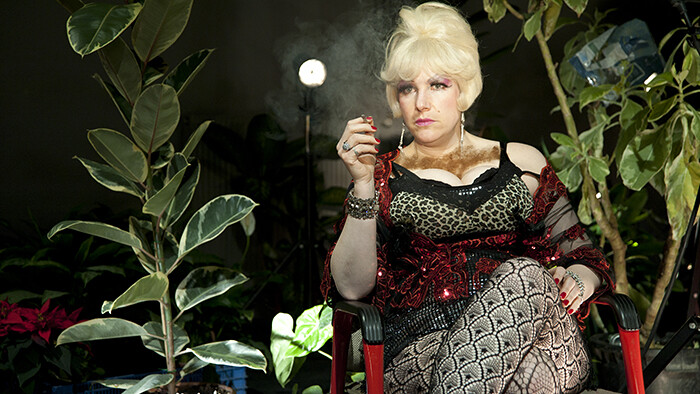In a clip from a 1985 BBC-TV interview, viewable on the BBC’s website, French writer and activist Jean Genet describes a dream he had in which the film crew revolted against the television-interview paradigm wherein a subject (in this case Genet himself) talks in front of a camera while half a dozen people off-camera—various technicians plus the director, interviewer, and interpreter—remain unseen and unheard. “Why don’t they come and push me out?” he goads before concluding his impromptu critique of normative behavior with the self-critical statement: “I am not annoyed with you for being part of the norm, I am annoyed with myself for accepting to come here.”1
Given that Berlin-based artists Pauline Boudry and Renate Lorenz share Genet’s passion for exposing and exploring societal norms and margins, it is not surprising to find this interview featured prominently in the artist-duo’s current exhibition, “Journal Notes from Backstage.” Based on their extensive research of various subcultures historically deemed “deviant” by hetero-normative cultures, Boudry and Lorenz have developed a diverse oeuvre of performances, films, photographs, installations, and publications, which feature figures like bearded women, transvestites, sadomasochists, and homosexuals. “Journal Notes from Backstage” showcases two recent works: Toxic (2012), a filmed performance screened in conjunction with various ephemera the artists collected during their research, and To Valerie Solanas and Marilyn Monroe in Recognition of their Desperation (2013), an 18-minute, 16mm film of musicians performing a 1970 arrangement of the same name by American composer Pauline Oliveros (b. 1932).
Entering the exhibition requires pushing past a turquoise, sequined curtain suggestive of a clandestine ingress to a peep show or underground performance. Beyond it, the installation Toxic encompasses the entire room; it consists of a projected HD transfer of a 16mm film accompanied by an assortment of related documents, photographs, and objects. In the film, Werner Hirsch (a recurring player from previous Boudry/Lorenz films) portrays Genet during his rebellious BBC-TV interview. Hirsch—the male persona of choreographer/performer Antonia Baehr—does a campy, but recognizable impression of Genet. Smoking a cigarette while flaunting hairy cleavage accentuated by a leopard push-up bra, Hirsh (who appears here dressed in drag although he is portraying a man) reenacts Genet’s tirade with just the right combination of agitation and distress. “Of course I want to break the order of things!” the heavily made-up, wig-wearing Hirsch barks, “If I am afraid to join the norm, then so be it.”
Elsewhere in the 13-minute film, which runs on a continuous loop, artist Ginger Brooks Takahashi (another Boudry/Lorenz regular) and Hirsh are featured in a slide show of frontal and profile mug shot-style portraits. Standing in front of a white backdrop, both appear in fanciful costumes that allude to various toxicities—environmental, medical, and cultural. Takahashi alternately sports a makeshift gasmask fashioned from a green plastic bottle and a hairy mask that makes her look like a Star Wars Wookiee. Hirsh, meanwhile, wears a too-tight, skin-colored girdle in one portrait and an eye-mask made from a prescription drug package in another. This series of images relates to a cache of nineteenth-century photographs the artists discovered in the archives of the city of Paris’s police headquarters, facsimiles of which are displayed like supporting evidence on two shelves mounted against the wall. These small, full-length, black-and-white portraits depict civilians arrested for being so-called pédérastes (an antiquated French term for gay men). Since the police department did not have its own photography studio in the 1870s, the arrestees were brought to a commercial studio where they were formally posed in a bourgeois setting—placed either in front of luxurious drapes, a velvet arm chair, or elaborate wall moldings. Several photographs of the same person, who is referred to as “Gounat” in the brief accompanying reports, capture the 22-year-old’s two different personae: a woman with a long braid in a flowing white dress and a dandy with a velvet jacket, walking cane, and spit curl.
Also on display as part of Toxic are photographs from the image volume of German sexologist and activist Magnus Hirschfeld’s 1930 Geschlechtskunde, auf Grund dreissigjähriger Forschung und Erfahrung bearbeitet [Sexology, Compiled from Thirty Years of Research and Experience], a multi-part publication on sexual minorities.2 Boudry and Lorenz have cropped Hirschfield’s illustrations of irrtümliche geschlechtsbestimmung (“mistaken gender assignment”) so that only the bottom sliver of each image and its descriptive caption are visible. For example, in Irrtümliche Geschlechtsbestimmung (als Frau lebender Mann) [Mistaken Gender Assignment (Man Living as a Woman)] (2013), the viewer is simply left to imagine the appearance (and the experience) of a “man living as a woman.”
Down two flights of stairs and past a fragment of blue sequined curtain, To Valerie Solanas and Marilyn Monroe in Recognition of their Desperation, transferred to digital HD, plays on a continuous loop in a dark room outfitted with two cinema-style seats and plush carpeting. Shots of a six-person band performing low, monotonous notes bring image and sound to a conceptual piece (of the same title) by Oliveros. Inspired by Solanas’s radical feminist SCUM Manifesto (1967), Oliveros’s original composition specifies that each musician choose five tones and hold them for an extended period time. Treating the non-hierarchical and anti-patriarchal themes that interested Solanas and Oliveros, Boudry and Lorenz’s filmed performance evokes an alternative utopian environment wherein improvisation, self-invention, and egalitarianism are the norm.
Jean Genet interview with Nigel Williams for BBC2 (November 12, 1985), http://www.bbc.co.uk/programmes/p0165yqc.
Magnus Hirschfeld, Geschlechtskunde, auf Grund dreissigjähriger Forschung und Erfahrung bearbeitet. Band IV: Bilderteil. Stuttgart: Julius Püttmann, 1926–1930.









